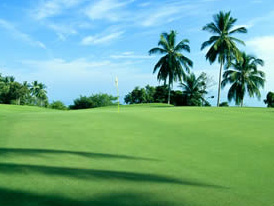| GREENS GRASSES FOR SOUTHEAST ASIA |
Background
Prior to the boom in golf course construction which started in the 1960s, the vast majority of greens in Southeast Asia were composed either of sand or indigenous grasses. With the ensuing surge in popularity of the sport, there was a demand for greens grasses that would provide a better quality of putting surface by both amateur and professional golfers alike.
The first generation of greens grasses were Bermudagrasses, including Tiffine, Tifgreen and Tifdwarf, the latter arriving in Southeast Asia in the late 1960s. These grasses were so named because of their origin in Tifton, Georgia, USA .
Problems
Tifdwarf and other members of this family of turfgrasses have a severe tendency to either become contaminated with off-type plants or to mutate and change their characteristics. This problem is accentuated when trying to achieve increased green speeds. In 1980, Dr. Wayne Hanna, a plant geneticist, made a collection of over 70 different plant types taken from putting greens that originated from these first generation grasses. Some were more aggressive than Tifdwarf, some weaker. Some plots were started from one single stolon and even these plots had mutated. The plants that occurred in these fields were ‘new mutation' events, whereby the plants replicate themselves in a continuing stream of variant plants. There is no way to prevent the occurrence of contaminates in these varieties. From the existing data available, Tifdwarf and these first generation greens grasses could be considered to be genetically unstable. One particular problem arises when pin placements are changed, increasing the likelihood that contaminates will be spread across the green. Thus, within a few years, the entire green is covered with spots. Most of the types that occur on greens have varying density, greater thatch, increased susceptibility to disease, an inability to withstand vertical mowing and severe grain problems.
The Way Forward
There is no easy solution for the off-type problem in the Tifdwarf family of grasses. It cannot be prevented and the best option for a golf course is to plan on re-grassing every 5-10 years and to obtain new planting material from a Nursery certified by the International Turfgrass Genetic Assurance Programme (ITGAP) that has variety pure planting stock. These nurseries are becoming more difficult to find especially with the introduction of the second generation of greens grasses, including Champion, Mini Verde, and TifEagle. Champion and Mini Verde are also off-types of Tifdwarf and will most likely change their genetics in the future.
|
TifEagle, however, was released by Dr. Hanna in the spring of 1998 and is the only variety that has different genetics than the Tifdwarf/Tifgreen family. The reason for this is that it has been genetically modified through cobalt radiation. To date, the number of off-types in TifEagle production fields have been limited and there is no documentation of a "mutation off-type" in a TifEagle green. Some of these greens are now over 6 years old and are at the stage where off-types would be very obvious in Tifdwarf. There is thus a strong case for golf courses with contaminated Tifdwarf on their greens to change to TifEagle.
Naturally this will require some management changes, but the improvement in putting quality should more than offset the increased management inputs. TifEagle can be cut to a height of 2.5-4 mms and with proper management can produce green speeds of between 10.5-11 feet.
Aside from the Bermudagrass ultradwarfs, as TifEagle and the second generation grasses are often referred to, there are also some new varieties of seashore paspalum grasses that are ideally suited to the warmer climate of Southeast Asia and which can produce an equally outstanding quality of putting surface, most specifically SeaIsle 2000
|

|
|
SeaIsle 2000 was developed by plant geneticist Dr. R.R. Duncan at the University of Georgia 's Griffin Experiment Station. Regular verti-cutting, light top-dressing and periodic rolling will deliver stimpmeter readings of between 9-10 feet. It is a grass that thrives on salt and poor quality water. As drinking water becomes more scarce, ocean water and other low-quality alternative sources are going to be the only option for many golf courses. Whilst requiring Superintendents to alter some of their management practices, SeaIsle 2000 will pay back dividends in reduced fertilizer, herbicide and recycled water costs.
It has received much acclaim in research trials in the USA for its disease resistance, turf quality, density and strength, its playability and rapid recovery from normal wear and tear. Its rich, dark green colour also makes for a highly aesthetic appearance.
Both TifEagle and SeaIsle 2000 are patented greens grasses, ensuring their long-term genetic purity and stability and protecting the investment of Golf Course Owners. Further information on can be found at www.tifeagle.com and www.seaisle2000.com . Ultimately though, the ‘perfect grass' does not exist – it all centres around sound management practice.
TifEagle and SeaIsle 2000 are exclusively licenced and distributed in Thailand and SE Asia by Quality Golf International Products Co., Ltd from their ITGAP certified Nurseries.
|

|
|
Superintendent Speak
Contamination - the unwanted introduction or appearance of another genotype
Mutation - any spontaneous change in the DNA that arises, survives and becomes a permanent part of the organism's genetic background.
Off-type - an individual grass plant which does not express the standard expected appearance due to changes in the genetic background, response to the environment, or both. Off-types are therefore either mutations or contaminants.
Stolon - an above ground creeping stem that can produce roots and shoots.
Thatch - organic layer of dead and living stems, shoots and roots of grasses that grow between the turf canopy and the soil
|